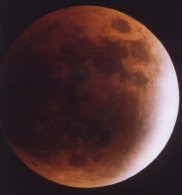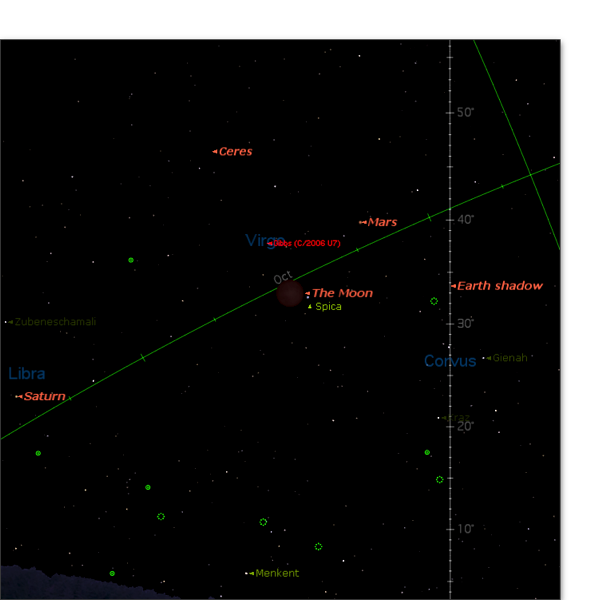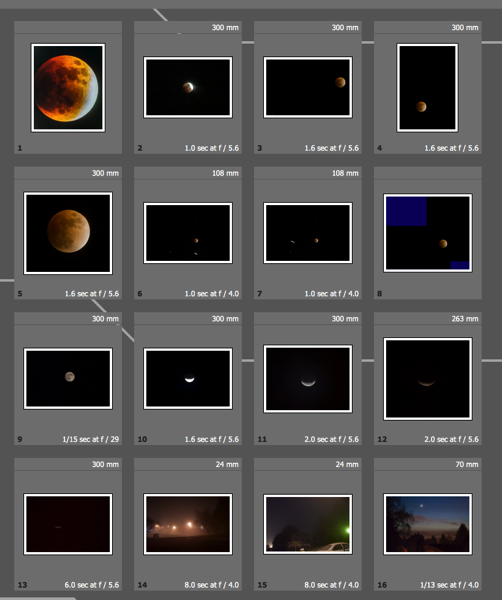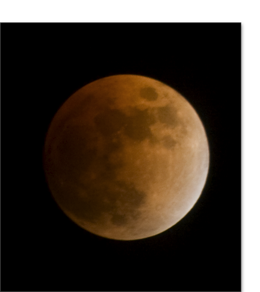A Photographic Opportunity
 The photo at the left is a Total Lunar Eclipse I took with a Celestron 8, with a focal length of 2032 mm.
The photo at the left is a Total Lunar Eclipse I took with a Celestron 8, with a focal length of 2032 mm.
That eclipse was on September 6, 1979 The photo was taken Somewhere near Bull Run off of Larch Mountain Road in Oregon. Sky and Telescope editors thought the dark splotch on the left was “unusual”.
The Moon will be Almost Due South at the start of totality at 12:07am PDT. The Moon will be 38 degrees above the Southern Horizon. Totality will end at 1:35 am PDT
This image is from “Starry Night” and shows the position of the moon at the beginning of totality as seen from Vancouver, WA…
Totality begins at 12:07 AM
Mars is just a little up and to the right of the Moon, quite bright at a magnitude of -1.5 Actually, Mars is at its closest approach to the Earth during the eclipse, the closest since 2007. Will any one see green flashes?
Spica is very, very near, about 2 degrees from the lower limb of the moon. Saturn is lower in the South Eastern sky.

The following table of eclipse times is from The April 2014 issue of Sky and Telescope

Lunar Eclipse, February 20, 2008
This image was taken with a Canon DSLR and a Sigma 70 - 300 mm zoom lens.
Exposure data
f/5.6 1.6 of a second, ISO 400 f.l. 300 mm
The image is well cropped…
Nice thing about a digital camera… you can see your results as you shoot…
You can see some of the 2008 and other eclipse photos on my website with a few surprises…

The Lunar Eclipse gallery was updated on March 19
http://www.uofgts.com/Lunareclipses/index.html
What you Need to Photograph the Eclipse!
Tripod
A digital camera capable of a “Timed Exposure” or a Manual shooting Mode.
Set the Aperture of the lens fully open… (Smallest number… if thou has a f/2.8 to f/11 lens… use f/2.8)
Length of exposure? You are going to have to experiment here… Time will depend on the f/stop, haze in the sky, and what ISO you are using. For an eclipse use IS0 100.
Zoom up so the moon is a large as possible, or zoom to include part of a building or tree in the image!
If you have different lenses try them all out! You can experiment here as the eclipse lasts approximately 1 hour and 20 minutes
Set Focus to infinity… If there is a bright street light in the distance, use that to set focus… If your camera has a “live” view, use it! In Live view mode magnify the image in the display screen to check focus… If it is slightly hazy out, you ‘ll have a Dicken’s of a time trying to focus… remember it’s not you or the equipment, it’s the Pacific NW sky!
Once you have done all that… lockup the mirror — if you have an DSLR… Canon buries the mirror lock setting in its Function Mode…
If your Camera has a live view, the mirror is already locked up.
Just one more thing
Use the timer function to trip the shutter. If you lockup the mirror and use the timer release, you’ll minimize “camera shake” caused by the slap of the mirror and the delicate touch of your finger on the shutter.
Have patience and have fun!

No comments:
Post a Comment